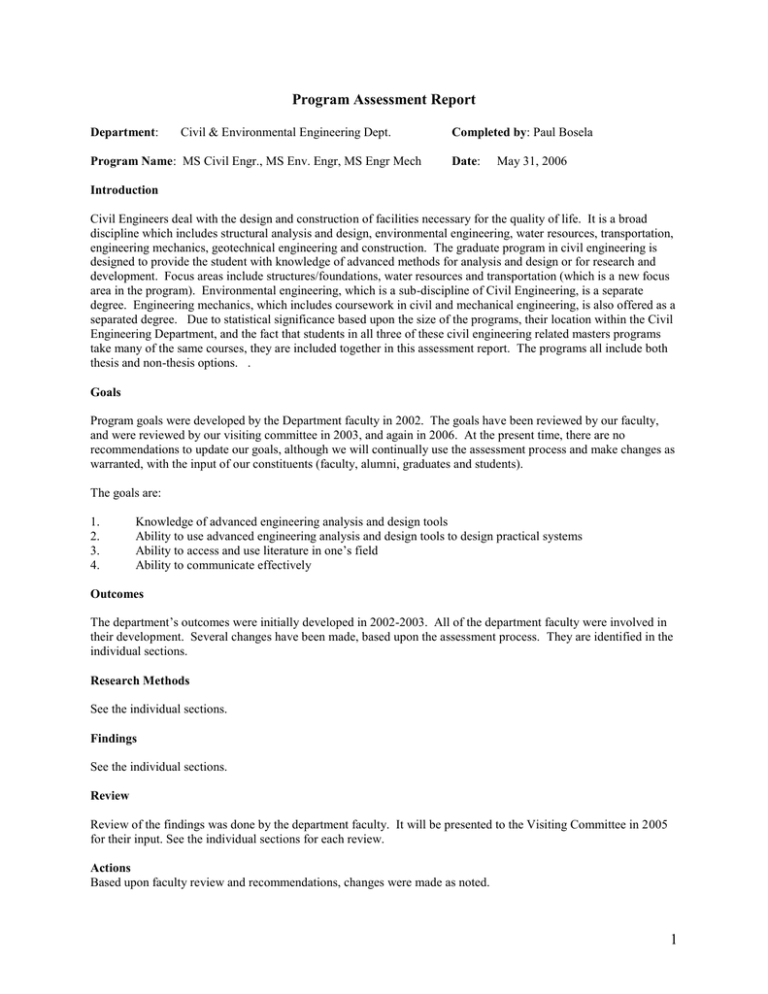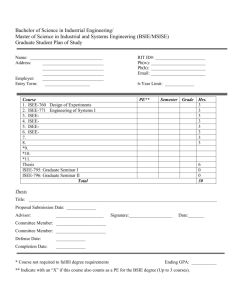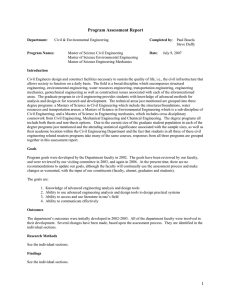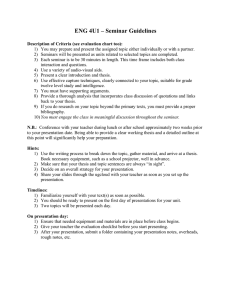Program Assessment Report
advertisement

Program Assessment Report Department: Civil & Environmental Engineering Dept. Program Name: MS Civil Engr., MS Env. Engr, MS Engr Mech Completed by: Paul Bosela Date: May 31, 2006 Introduction Civil Engineers deal with the design and construction of facilities necessary for the quality of life. It is a broad discipline which includes structural analysis and design, environmental engineering, water resources, transportation, engineering mechanics, geotechnical engineering and construction. The graduate program in civil engineering is designed to provide the student with knowledge of advanced methods for analysis and design or for research and development. Focus areas include structures/foundations, water resources and transportation (which is a new focus area in the program). Environmental engineering, which is a sub-discipline of Civil Engineering, is a separate degree. Engineering mechanics, which includes coursework in civil and mechanical engineering, is also offered as a separated degree. Due to statistical significance based upon the size of the programs, their location within the Civil Engineering Department, and the fact that students in all three of these civil engineering related masters programs take many of the same courses, they are included together in this assessment report. The programs all include both thesis and non-thesis options. . Goals Program goals were developed by the Department faculty in 2002. The goals have been reviewed by our faculty, and were reviewed by our visiting committee in 2003, and again in 2006. At the present time, there are no recommendations to update our goals, although we will continually use the assessment process and make changes as warranted, with the input of our constituents (faculty, alumni, graduates and students). The goals are: 1. 2. 3. 4. Knowledge of advanced engineering analysis and design tools Ability to use advanced engineering analysis and design tools to design practical systems Ability to access and use literature in one’s field Ability to communicate effectively Outcomes The department’s outcomes were initially developed in 2002-2003. All of the department faculty were involved in their development. Several changes have been made, based upon the assessment process. They are identified in the individual sections. Research Methods See the individual sections. Findings See the individual sections. Review Review of the findings was done by the department faculty. It will be presented to the Visiting Committee in 2005 for their input. See the individual sections for each review. Actions Based upon faculty review and recommendations, changes were made as noted. 1 1-1. Goal #1 Knowledge of advanced engineering analysis and design tools 2a. Outcome Measure #1 3a. Research Completed Thesis defense questionnaire for thesis committee faculty 26 evaluation forms were received. 4a. Findings Question 1a, depth of knowledge, 35 % checked exemplary, and the remaining 65 % satisfactory. Question 1b, breadth of knowledge, 46 % checked exemplary, and the remaining 54 % satisfactory. Question 2, , familiarity with advanced methods of analysis and synthesis, 46 % exemplary, 54% satisfactory 5a. Review 6a. All of the above evaluations indicate that the students met or exceeded the objective. Actions None required. 7a. Improvement This was the first use of the new questionnaire, which is a better assessment tool than the previous one. 2 1-1. Goal #1 Knowledge of advanced engineering analysis and design tools 2b. Outcome Measure #2 Exit survey 3b. Research Completed 10 evaluations forms were received and reviewed. . 4b. Findings Based on a score 1=unacceptable, 2=poor 3=average, 4=good, and 5=excellent) Question 1, knowledge of advanced analysis tools, Mean = 4.1, standard deviation = 1.101 Question 2, knowledge of advanced design tools, Mean = 4.0, standard deviation = 1.247 . Review Based on the above scores, the criterion has been exceeded.. 6b. Actions None required. 7b. Improvement 5b. . 3 1-1. Goal #1 Knowledge of advanced engineering analysis and design tools 2c. Outcome Measure #3 3c. Research Completed Faculty follow well-defined syllabi with specific engineering analysis and design topics defined, use exam testing on subject matter to demonstrate knowledge gained by the students, and a graduate level grading system. Courses which are dual-listed with senior technical electives follow ABET (Accreditation Board of Engineering and Technology ) syllabi. 4c. Findings Classroom performance Graduate gpa 5c. Review Minimum 3.0 gpa for graduation 6c. Actions Structured coursework and minimum gpa assures compliance 7c. Improvement 4 1-2. Goal #2 Advanced engineering analysis and design tools to design practical systems 2a. Outcome Measure #1 3a. Research Completed Thesis defense questionnaire for thesis committee faculty . 4a. Findings 5a. Review Since it is not the intention for each thesis to demonstrate the use of engineering and design tools to design a practical system, this is being removed as an outcome measure for this goal and will not be included in future reports. 6a. Actions . 7a. Improvement 5 1-2. Goal #2 Advanced engineering analysis and design tools to design practical systems 2b. Outcome Measure #2 Exit survey 3b. Research Completed 10 evaluation forms were received and reviewed . 4b. Findings Based on a score 1=unacceptable, 2=poor 3=average, 4=good, and 5=excellent) Question 3, learned how to use analysis and design tools to design practical systems, Mean = 3.8, standard deviation = 1.229 5b. Review Based on the above scores, the criteria has been exceeded. 6b. Actions 7b. Improvement None required to meet criteria. 6 1-2. Goal #2 Advanced engineering analysis and design tools to design practical systems 2c. Outcome Measure #3 3c. Research Completed Faculty follow well-defined syllabi with specific engineering analysis and design topics defined, use exam testing on subject matter to demonstrate knowledge gained by the students, and a graduate level grading system. Courses which are dual-listed with senior technical electives follow ABET (Accreditation Board of Engineering and Technology ) syllabi. 4c. Findings Classroom performance Graduate gpa 5c. Review Minimum 3.0 gpa for graduation 6c. Actions Structured coursework and minimum gpa assures compliance 7c. Improvement None required 7 1-3. Goal #3 Access and use of literature in one’s field 2a. Outcome Measure #1 Thesis defense questionnaire for thesis committee faculty 3a. Research Completed 26 evaluation forms were received.. 4a. Findings For question 3, ability to independently read and understand the significance and limitations of the relevant literature, 46 % checked exemplary, and 54 % satisfactory. 5a. Review Criteria has been met. 6a. Actions None required. 7a. Improvement 8 Access and use of literature in one’s field 1-3. Goal #3 2b. Outcome Measure #2 Exit survey 3b. Research Completed 5 evaluation forms were received and reviewed . 4b. Findings Based on a score 1=unacceptable, 2=poor 3=average, 4=good, and 5=excellent) Question 4, learned how to access the literature in my field of study, the mean score was 4.3, the standard deviation was 1.252. 5b. Review Based on the above scores, the criteria has been exceeded. 6b. Actions None required. New seminar course includes training in literature search, and using it in seminar presentation. 7b. Improvement 9 1-4. Goal #4 Ability to communicate effectively 2a. Outcome Measure #1 Thesis defense questionnaire for thesis committee faculty 3a. Research Completed 26 review forms were received. 4a. Findings There are six measurements under question four, ability to communicate effectively, that are included on the survey form. The responses were as follows: Quality of the writing style Organization of the written dissertation/thesis Organization of the presentation Clarity of language usage Ability to answer questions Quality of slides 5a. Level of Achievement (%) Exemplary Satisfactory Unsatisfactory 38 46 15 58 42 69 31 65 35 62 38 73 27 Review Quality of the writing style at the time of thesis defense was the only measure not met every time. (It was met 85 % of the time. Students were required to fix grammatical errors before thesis was accepted. Criteria has been met. 6a. Actions Faculty advisors encouraged to review draft thesis for grammatical errors prior to defense. 7a. Improvement This was the first use of the new questionnaire, which is a better assessment tool than the previous one. 10 1-4. Goal #4 Ability to communicate effectively 2b. Outcome Measure #2 Exit survey 3b. Research Completed 10 evaluation forms were received and reviewed. 4b. Findings Based on a score 1=unacceptable, 2=poor 3=average, 4=good, and 5=excellent) Question # 6, Learned to improve my oral communication skills, mean = 4.2, standard deviation = 1.033 Question #7, learned to improve my written communication skills, mean = 4.3, standard deviation = 0.949. 5b. Review Based upon the above scores, the criteria has been exceeded. 6b. Actions Use of ProSkills in the seminar course will be continued. 7b. Improvement 11 1-4. Goal #4 Ability to communicate effectively 2d. Outcome Measure #3 consultant. 3d. Research Completed The students received a training lecture on presenting professional presentations. The oral presentations by the seven graduate students who took this course were videotaped and evaluated. The videotapes and associated critiques were given to the respective students. 4d. Findings Seminar course oral presentation and critique by outside The mean scores in the various areas for the group of students were as follows: Subject knowledge Evidence of Preparation Quality of Visuals Adaptation to audience Style/Enthusiasm Voice projection/control Composure/eye contact (Excellent = 18-20) (Excellent = 14-16) (Excel.=14-16, Avg.=11-13, Need to improve 8-10.) (Excellent = 12, Average – 10, Need to improve = 8) (Excellent = 12, Average – 10, Need to improve = 8) (Excellent = 12, Average – 10, Need to improve = 8) (Excellent = 12, Average – 10, Need to improve = 8) Mean score 18.3. 14.2. 12.3 10.7 11.4 11.0 10.2 Total 88.3 The database for 900+ CSU engineering students over multiple years (undergraduate and graduate) has a mean score of 89.5. Since that database is predominantly American students, and the majority of students in the Masters program seminar course have English as a second language, the performance was extremely favorable. 5d. Review Based upon the above scores, this course is improving the oral presentation skills, and should be continued. With the videotape and critique provided to the students, it is expected that they will continue to improve their oral presentation skills before graduations. 6d. Actions Use of ProSkills in the seminar course will be continued. 7d. Improvement 12 13 14 15 16 17




